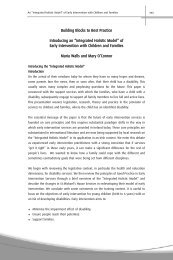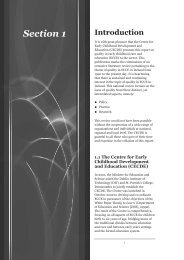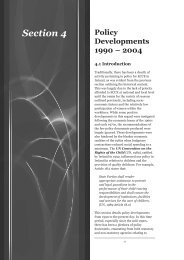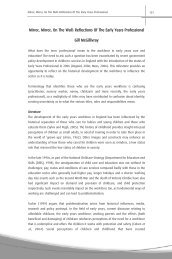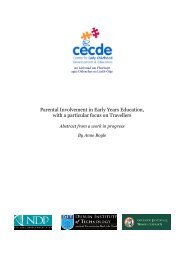Sweden - Centre for Early Childhood Development & Education
Sweden - Centre for Early Childhood Development & Education
Sweden - Centre for Early Childhood Development & Education
You also want an ePaper? Increase the reach of your titles
YUMPU automatically turns print PDFs into web optimized ePapers that Google loves.
Chapter 4<strong>Sweden</strong>vouchers. Since 1992, private <strong>for</strong>-profitcommercial firms were eligible to receivepublic funding <strong>for</strong> running day careservices (Pestoff and Strandbrink, 2002).In January 2002, a nation-wide fee ceilingknown as the "Max Tax" was introduced(Petrie et al., 2003), meaning that feescannot exceed a certain sum, which had theeffect of reducing the cost <strong>for</strong> many families(OECD, 1999b). Under the "Max Tax", theparental fee <strong>for</strong> one child attending a preschoolcentre is three percent of householdincome, be<strong>for</strong>e tax, up to a maximum ofSEK1,140 a month (€122 as of July 2002);<strong>for</strong> a second child parents pay two percentof household income and <strong>for</strong> a third childone percent. No fees are charged on fourthand subsequent children. According toPestoff and Strandbrink (2002:25), this hasstandardised the funding of childcareprovision through the voucher system <strong>for</strong>all children in <strong>Sweden</strong>The 1998 School Act requires localauthorities to provide childcare at a preschool,at a leisure time centre or in afamily day care home without undue delay(generally interpreted as within a threemonth period) to facilitate parents to workor study (Swedish Institute, 2001). FromJuly 2000, local authorities are required tooffer a pre-school place <strong>for</strong> at least threehours a day to children of unemployedparents. From January 2002, this alsoapplied to children from families where oneof the parents is at home on parental leavelooking after a brother or sister (SwedishInstitute, 2001). As of January 2003, allfour and five year olds are entitled to threefree hours of pre-school a day from theautumn term of the year they turn four.Provision of this is mandatory by localauthorities but children's attendance isvoluntary.Though compulsory schooling begins atseven, since 1998 municipalities have beenobliged to provide all six year olds with aplace in a pre-school class <strong>for</strong> at least 525hours per year. Though attendance at theseclasses is voluntary, virtually all six youolds attend. <strong>Sweden</strong> is moving to universalprovision; the government's long-term goalis the provision of free childcare facilities,which are available to all (Skolverket,2000).4.2.4 Delivery StrategyThe delivery strategy in terms of ECCE in<strong>Sweden</strong> is a supply strategy, as mostprovision is publicly funded and publiclydelivered. However non-municipalprovision of day care services (alternativdrift [alternative provision] or enskild[private] services) expanded following 1985(Pestoff and Strandbrink, 2002).In 1991, the conservative governmentintroduced the idea of freedom of choice;that pre-school provision would beprivately organised but publicly funded.This led to an increase in non-municipalday care services. Pestoff and Strandbrink(2002) note that the development of nonmunicipalday care services has proceededvery unevenly with privately owned servicesmore likely to develop in urban than ruraland sparsely populated areas.Non-municipal day care services includeparent co-ops, voluntary organizations,worker co-ops, organizations with specialpedagogies, and a combination of these orother <strong>for</strong>ms. In particular, parent co-opswitnessed an increase in the early 1990s, asthey were often the only chance <strong>for</strong> parentsto obtain a day care place. Parent co-opsare based on parental participation andinfluence, and parents have more roles thanin municipal day care services. In 1986,there were only eighteen parent co-ops inStockholm, but by 1990 it had grown to140, and by 1995 there are about 200parent co-ops (Pestoff and Strandbrink,2002).According to Pestoff and Strandbrink(2002), nearly two-thirds of the nonmunicipalday care facilities in 1995 wereeither provided by parent and worker52



